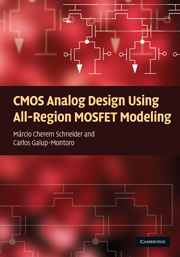Book contents
- Frontmatter
- Contents
- Preface
- 1 Introduction to analog CMOS design
- 2 Advanced MOS transistor modeling
- 3 CMOS technology, components, and layout techniques
- 4 Temporal and spatial fluctuations in MOSFETs
- 5 Current mirrors
- 6 Current sources and voltage references
- 7 Basic gain stages
- 8 Operational amplifiers
- 9 Fundamentals of integrated continuous-time filters
- 10 Fundamentals of sampled-data circuits
- 11 Overview of MOSFET models and parameter extraction for design
- Index
- References
2 - Advanced MOS transistor modeling
Published online by Cambridge University Press: 17 December 2010
- Frontmatter
- Contents
- Preface
- 1 Introduction to analog CMOS design
- 2 Advanced MOS transistor modeling
- 3 CMOS technology, components, and layout techniques
- 4 Temporal and spatial fluctuations in MOSFETs
- 5 Current mirrors
- 6 Current sources and voltage references
- 7 Basic gain stages
- 8 Operational amplifiers
- 9 Fundamentals of integrated continuous-time filters
- 10 Fundamentals of sampled-data circuits
- 11 Overview of MOSFET models and parameter extraction for design
- Index
- References
Summary
Analog designers require MOSFET models that are accurate for (numerical) circuit simulation, but they also need models that are simple enough to allow design (at a symbolic level) that captures the essential non-linearity of the transistors. Clearly, the analysis and design models must be consistent in order to allow a smooth transition between design and analysis. Ever since the origins of MOS circuit design, until recently, the most popular compact models for design have been based on the threshold-voltage (VT) formulation. This class of models relies on approximate solutions that are accurate only in the limit cases of strong- and weak-inversion operation, and no accurate model is available for the transition (moderate-inversion) region between them. VT models are no longer acceptable for analog circuits in advanced, low-voltage technologies, where the moderate-inversion region is increasingly important. For this reason, compact models strongly based on the MOS transistor theory, which are accurate in all the operating regions of the transistor, will be summarized in this chapter. The fully consistent and simple charge-based MOSFET model will be reviewed in Section 2.1. The model presented here preserves the symmetry of the conventional rectangular-geometry transistor, an important property on which several circuits are based. A design-oriented current-based model is summarized in Section 2.2. The dynamic models, including expressions for nine linearly independent capacitive coefficients of the four-terminal transistor and a non-quasi-static model are presented in Section 2.3, and the main short-channel effects are rapidly reviewed in Section 2.4.
Information
- Type
- Chapter
- Information
- CMOS Analog Design Using All-Region MOSFET Modeling , pp. 26 - 87Publisher: Cambridge University PressPrint publication year: 2010
References
Accessibility standard: Unknown
Why this information is here
This section outlines the accessibility features of this content - including support for screen readers, full keyboard navigation and high-contrast display options. This may not be relevant for you.Accessibility Information
- 1
- Cited by
